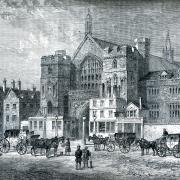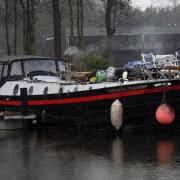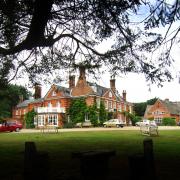When we think of Nelson we tend to remember his great victories – the Battles of the Nile, Copenhagen and Trafalgar in particular, but things didn’t always go so well.
Some years ago, I came across an anecdote about the hero which I would dearly love to believe is true.
It’s said that, when he returned victorious from the Battle of the Nile, to Gorleston, the denizens of Yarmouth decided to give him the freedom of the borough. To this end he was collected by carriage and, before cheering crowds, was driven to the bridge, at which point the horses were replaced by sailors who pulled the carriage to the site of the ceremony. And, it’s here that the first doubts as to the authenticity of the anecdote begin. Why on earth would the corporation choose as the site of such a prestigious ceremony a pub, particularly one with the rather unattractive name The Wrestler’s Arms?

But my scepticism is not wholly justified, at least as to the location chosen. The Wrestlers was a substantial building. By the mid-18th century it was the largest hostelry in the town. Purchased in 1787 by one John Suckling it had, by 1800, the date of Nelson’s arrival, been inherited by Suckling’s widow, Sarah. Located on Church Plain it was clearly a good central point for an important event and it is generally accepted that it was the site of such a ceremony, Nelson being accompanied by the heavily pregnant Lady Hamilton and her cuckolded husband, Sir William. Nelson is said to have been delighted by the cheering crowds who thronged the streets and to have expressed his delight at being a man of Norfolk. Following the ceremony, the mayor and Nelson, accompanied by many officers and dignitaries, attended a thanksgiving service at St Nicholas Church at which the organ played See the Conquering Hero Comes.
My scepticism relates to the alleged faux pas made by the town clerk at the key point in the ceremony when Nelson placed his hand on the Bible to swear the necessary oath. At this point the town clerk is said to have intervened to tell Nelson that he must use his right hand, not his left. ‘Sorry’, Nelson is reported as replying, ‘I left that at Tenerife’.
It is the action at Tenerife that I referred to in the title as Nelson’s bad day at the office. Nelson, at this stage a newly promoted rear admiral, was despatched with a substantial squadron with his orders requiring him ‘to take the ships under your command and to proceed with the utmost expedition off the Island of Tenerife and there to make your dispositions for taking the town of Santa Cruz by a sudden and vigorous assault’.

There were two main reasons for the decision to despatch Nelson to Tenerife. First, mutiny was in the air. The Spithead mutiny, a few months earlier, had been followed by a further one at the Nore where ships taken over by mutineers actually fired on those that didn’t join the mutiny. A long period of relative inactivity blockading Cadiz, waiting in vain for the Spanish to emerge for a fight, frustrated the fleet’s officers and might make the crews mutinous. Second, the economic position at home was grave. Funding the cost of the war was proving too difficult even for the fiscal genius of Pitt, and Tenerife was a stopping off point for the treasure galleons returning from Mexico – a tempting target for a cash-strapped nation. A successful action would provide the men with much needed diversion and the country with a healthy injection of cash – it might also remove Spain from active involvement in the war. Encouragement was derived from a recent raid on Tenerife by two frigates which, in a surprise night attack, had managed to capture two ships.
One of Nelson’s great strengths was his collegiate approach. A meticulous planner himself, he always involved his subordinates in the development of tactics for action, and was always open to suggestions and discussion. No less than four times on the voyage to Tenerife he called the captains of all the ships in his command to attend him on the flagship to develop detailed arrangements for achieving their objectives. There was no long-term plan to colonise the island, what was required was to take the port of Santa Cruz by force and capture any treasure ships which fell into the trap.
The plan agreed was, at first sight, a sound one. Santa Cruz was a fortified town with a small garrison. Although intelligence suggested that it was not strongly held it had good fortifications and a particularly astute commander. General Antonio Gutierrezz de Otero y Santayana an experienced officer who had been successful against the British before. The recent night-time English attack had served as a warning to him and he had worked hard to improve the defences.

Nelson and his officers decided that a sensible course would be to land a couple of miles from the town and capture Fort Paso Alto, on a height overlooking the city, and having done so, to issue an ultimatum to the Spanish demanding their surrender.
Scaling ladders and all necessary equipment, with a force of 900 sailors and marines, were to be landed at night and as silently as possible, to achieve surprise. The ships undertaking this landing were to be commanded by Captain Troubridge. There were immediate problems – both the weather and the sea conditions were unhelpful and the element of surprise did not prevail - the garrison was alerted. Troubridge failed to press on and went back to seek Nelson’s advice. A further attempt was made in daylight, but the invading force, in broiling heat and burning sun, took the wrong route and were recalled.
By this time, Nelson was probably apoplectic. Faced with either having to return with his tail between his legs or making a frontal assault on the town, he chose the latter. He knew the risks – and they were getting greater. Gutierrezz, realising that the attempt on Paso Alto had been abandoned, secretly used most of the garrison there to strengthen the defences of the town. Fort St Cristobal was a formidable obstacle well-equipped and with a strengthened garrison it commanded the approaches to the town.
The British landings, spearheaded by Nelson himself were a shambles. Again, the attack was to be at night and secrecy was to be achieved by taking every precaution - even muffling the oars. Again, secrecy was not achieved and strong tides meant that the landing craft instead of landing at the Mole in a concentrated force were scattered along the front. The garrison, alerted, responded with spirit and withering fire. Nelson, who had planned to lead the attempt personally didn’t even make it ashore. His boat came under heavy fire just as he was on the point of landing and he was hit by a musket ball in the right arm, cutting a major artery. Nelson might well have died, but for the quick thinking of his stepson, Josiah, who applying a torniquet to staunch the heavy bleeding, took the boat straight back to the fleet, where Nelson’s arm was amputated, Nelson complaining of the coldness of the steel of the surgeon’s knife. His sangfroid was remarkable – he insisted on climbing back on to the ship unaided and was back at work after the operation within the hour!
The situation he had to face was certainly discouraging, if a little confused. Some groups had managed to get past the initial defences but isolated parties were in danger of being trapped. Having attempted a bluff, which was called, those who had landed were released by the chivalry of Guiterrezz on giving an undertaking not to return. The Spanish commander even went so far as to allow those trapped to return to the fleet without surrendering their weapons. He wasn’t just chivalrous, he was cunning. He told his captives that the size of the garrison was more than four times its actual size. In a way, it flattered the defeated British, but it also made it unlikely that they would try again!

The Spanish still celebrate their success. Where today the cruise ships disgorge their passengers, on the site of the former Fort Cristobal, there is a lake below which there is a museum. Among the exhibits is the gun from which it is claimed the ball which hit Nelson was fired. Now that claim does make me sceptical!
Back on his flagship, Nelson became very depressed, writing (for the first time with his left hand) ‘I am become a burthen to my friends and useless to my Country’. Reporting back to Admiral Jervis, he found a much more sympathetic view of his actions prevailed and he gradually emerged from his depression – just as well for his country given his subsequent success.
And the hunk of cheese? Nelson appreciated the chivalry of Guiterrezz and wrote to thank him, sending him a barrel of English ale and a cheese. Nelson’s letter to him accompanying the cheese survives and is in the military museum at Toledo. Of what happened to the beer, however, no record survives!
And the Wrestler’s Arms? Well, Mrs Suckling asked Nelson for permission to re-name her hostelry the Nelson Arms. He declined the honour saying that since he only had one arm, the name would be absurd.




























